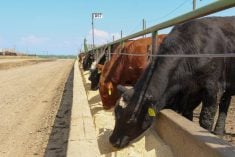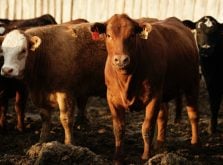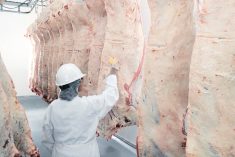Western Canadian feedlot margins have hovered in negative territory throughout the summer and early fall. In late September, Alberta packers were buying fed cattle on a dressed basis in the range of $231 to $232; live bids were quoted from $136 to $139. Recent prices are about $15 to $20 below break-even pen closeout values.
Despite the negative margins, yearling values continue to trade near 52-week highs. In the Lethbridge area, larger-frame medium-flesh steers weighing 850 pounds were trading as high as $208 and similar quality 950-pound steers were valued at $182. The market fed cattle outlook for winter and early spring has improved over the past month because U.S. beef production is expected to drop below year-ago levels during the fourth quarter.
Read Also

Harvest wraps up and fall work begins
At the Eppich famly ranch in western Saskatchewan, the fall harvest was successful with few breakdowns, cows and calves have been sorted and a new tractor has arrived
While yearling prices have been very strong, calf prices are trading $10 to $15 below a year ago. Barley prices have dropped over $100/mt from the summer highs but beef supplies during the summer of 2020 will extremely burdensome. This will set a negative tone for yearling values during the first quarter of 2020 — fed cattle prices next summer have the potential to drop to 10-year lows.
Therefore, calf prices are on the defensive as the market functions to encourage contraction over the next year. The U.S. year-to-date beef cow slaughter is up about 11 per cent from last year but the market has more work to do longer term. As of late September, steers weighing 550 pounds were trading in the range of $210 to $215 in central Alberta while similar-weight heifers were quoted from $185 to $194. Cow-calf and backgrounding operators will need to be prudent risk managers because the market will experience extremes over the next eight months.
Fed cattle prices dictate the direction of the feeder market. Therefore, it’s important to realize the changes in beef production each month. U.S. cattle-on-feed numbers as of Sept. 1 came in at 10.982 million head, down 143,000 or 1.3 per cent from 11.125 million head on Sept. 1 of 2018. Feedlot placements during August were 1.884 million head, down nine per cent from August of last year. U.S. fed cattle marketings during August were 1.953 million head, also down two per cent from August 2018. It’s important to realize that placements were below year-ago levels in each weight category. According to Statistics Canada, western Canadian finishing operations were holding 1.215 million head on July 1, up 5.5 per cent from July 1 of 2018.
The USDA is now forecasting 2019 fourth-quarter beef production to finish near 6.790 billion pounds, down 65 million pounds from the fourth quarter of 2018. Earlier in summer, the industry was expecting fourth-quarter production to finish over seven billion pounds so this is a major change.
The fed cattle market is currently moving through seasonal lows and will likely percolate higher in November and December. The USDA is projecting 2020 first-quarter production at 6.615 billion pounds, up nearly 200 million pounds from last year. The placement structure throughout the summer and fall suggests that this may be too high.
I’m actually expecting 2020 first-quarter production to finish at similar levels to 2019. However, the second-quarter production is projected to reach over 7.0 billion pounds. The fed cattle market will contend with a very tight supply from January through March but very burdensome stocks from April through June.
Given the market outlook for fed cattle, I’m expecting yearling prices to trade sideways throughout October. During November and December, prices for feeder cattle over 800 pounds are projected to soften. The yearling market is expected to trend lower during the first quarter of 2020. I’ve been advising ranchers and backgrounding operators to be aggressive with yearling sales. The western Canadian cash price has divorced from the feeder futures because of the low barley prices in Western Canada. Therefore, it doesn’t make sense to use livestock price insurance for yearlings. The feeder cattle futures are trading just above 52-week lows at the time of writing this article.
The calf market is expected to be extremely volatile over the winter. We may see minor strength in the calf market once yearling supplies dry up this fall but the upside will be limited. During the first quarter of 2020, calf prices are also expected to trend lower because of the bearish outlook for fed cattle during the second and third quarters of 2020. Currently, western Canadian calf prices are near 52-week lows. Many farmers are asking if they should background their calves given the abundant supplies of feed wheat and barley. This may be logical given current feed and calf prices. However, you’ll need to be aggressive with your price protection when feeder cattle futures make seasonal highs over the winter because there is significant downside risk next year.

















